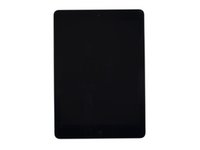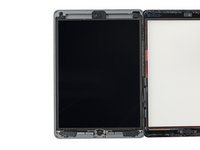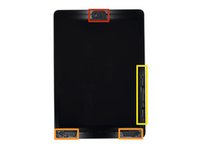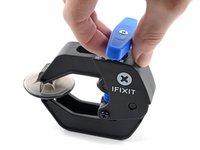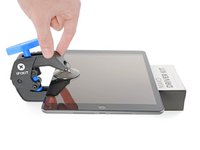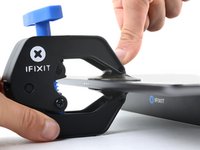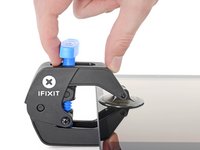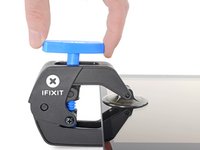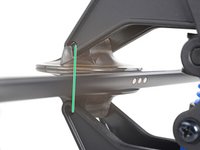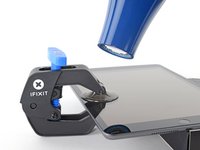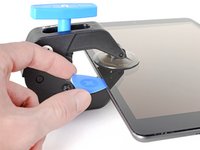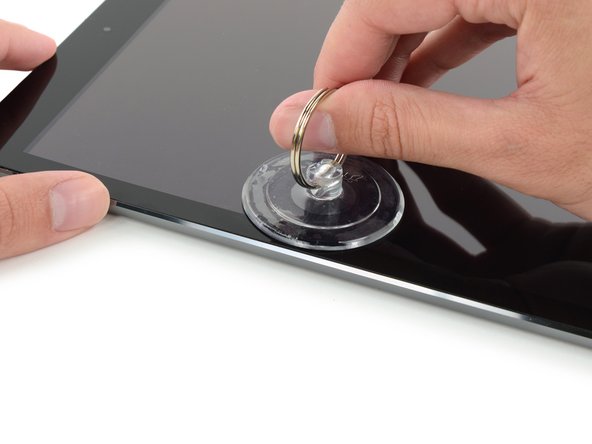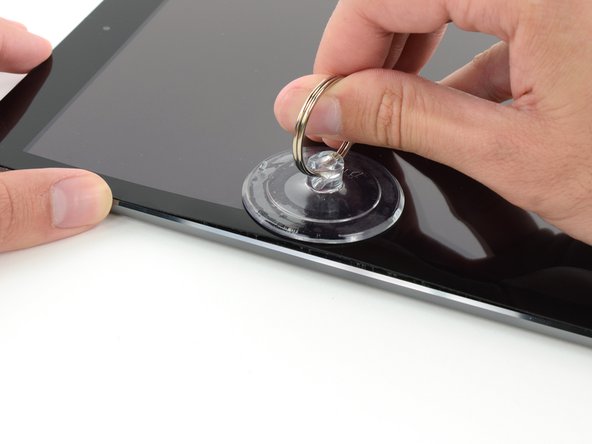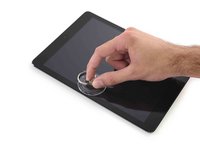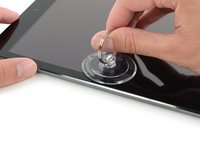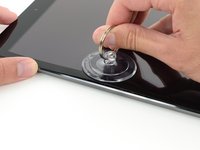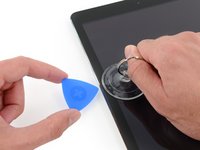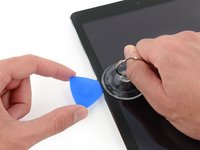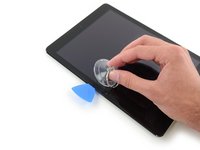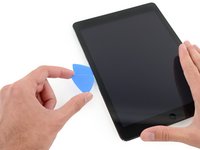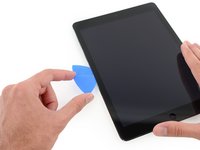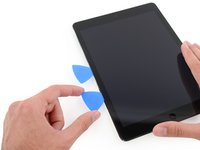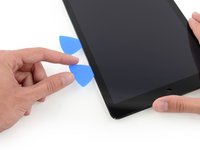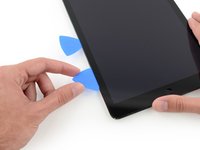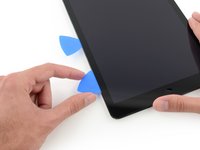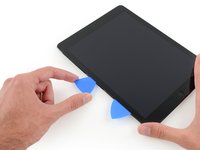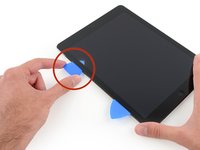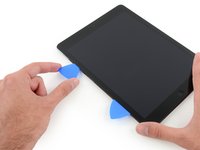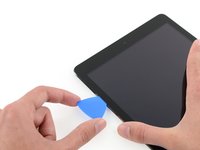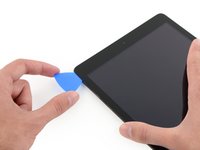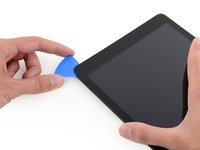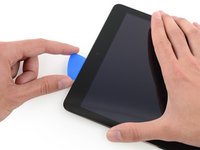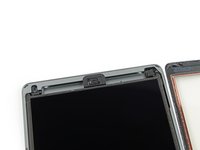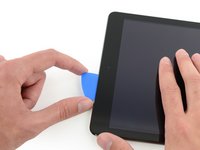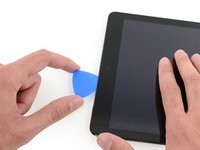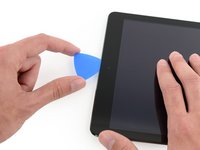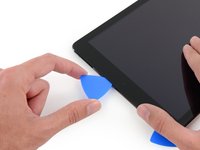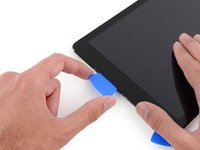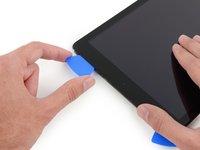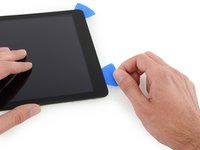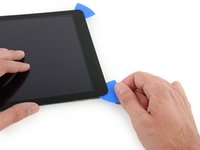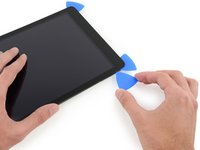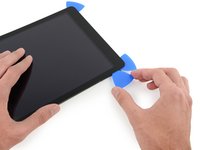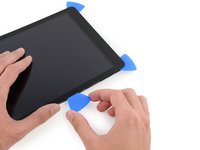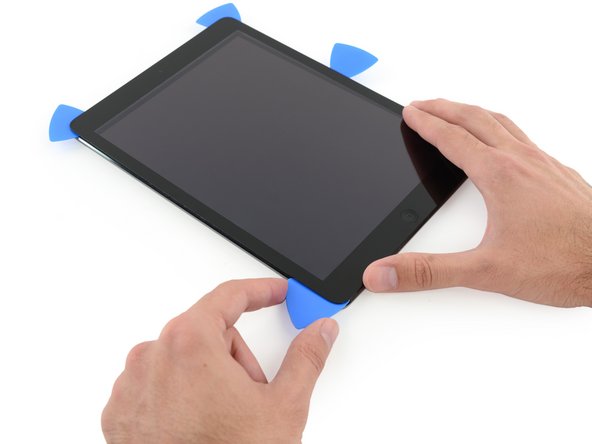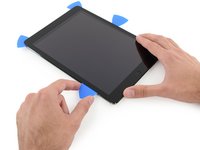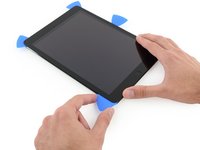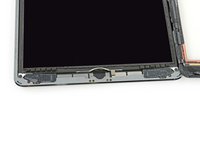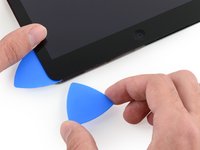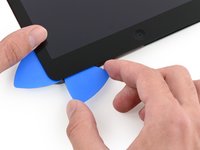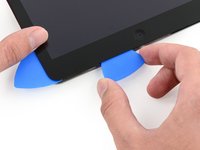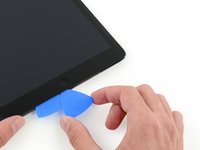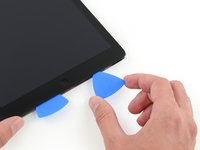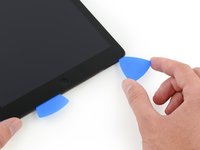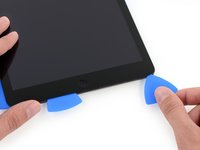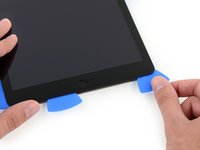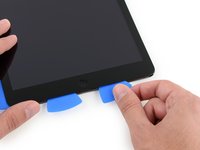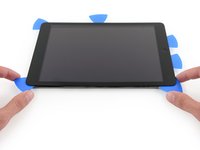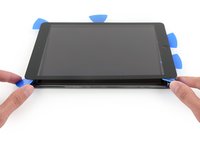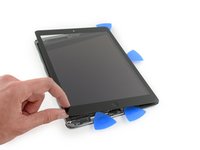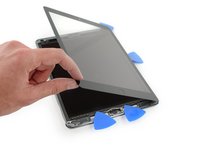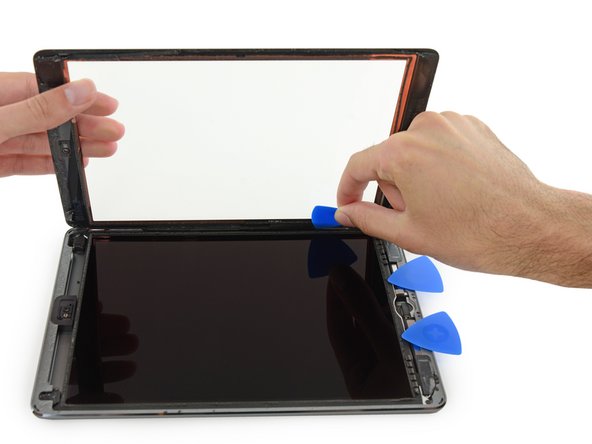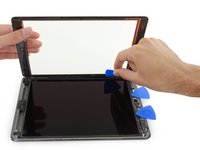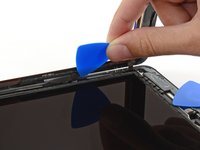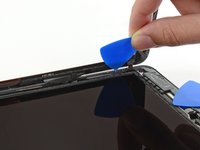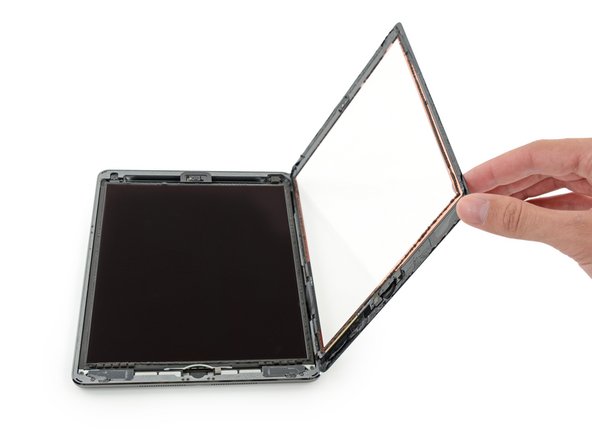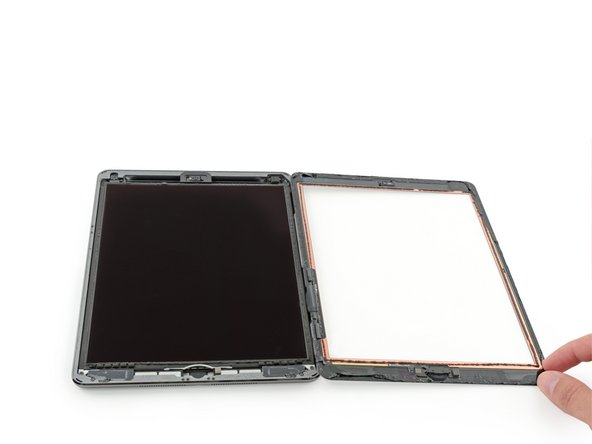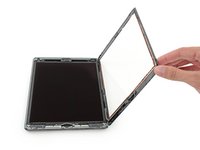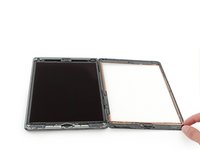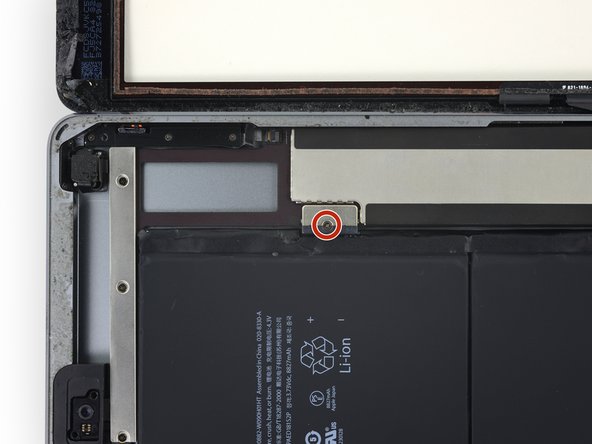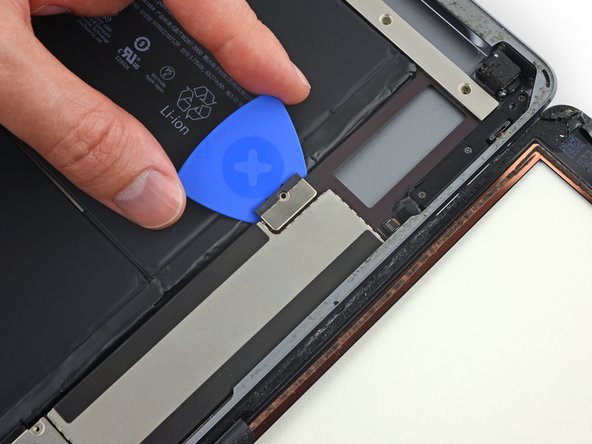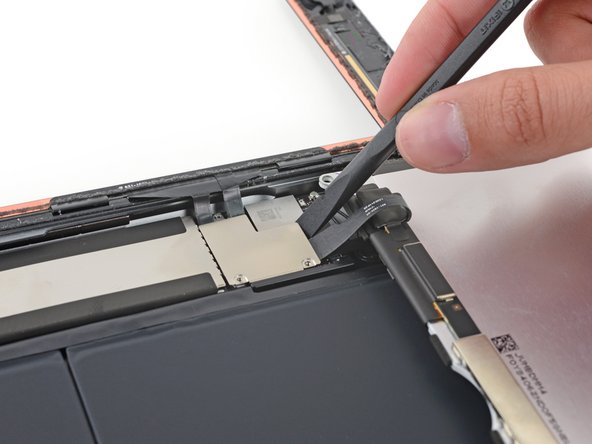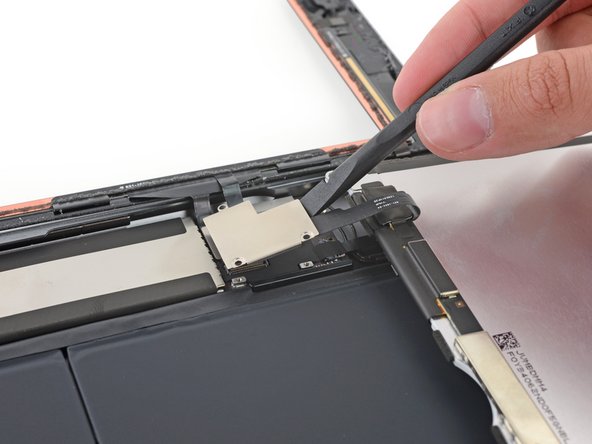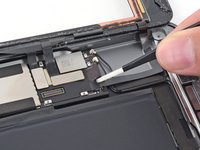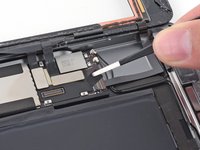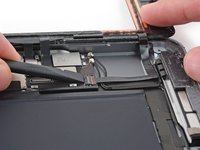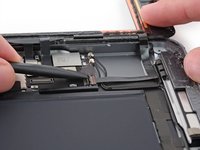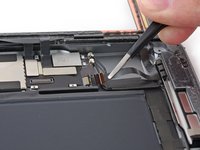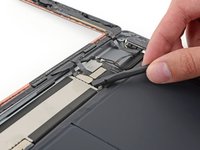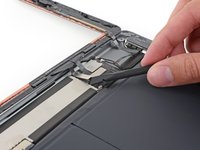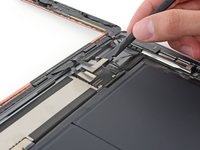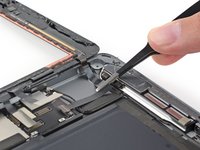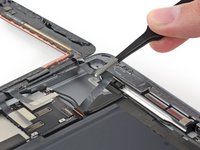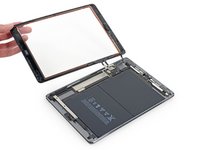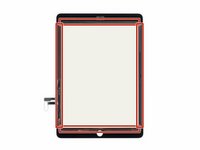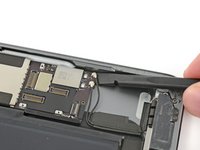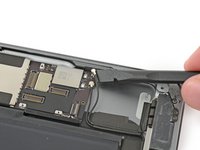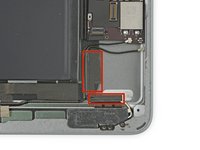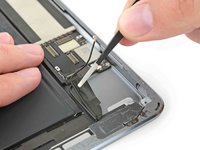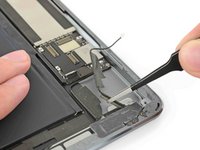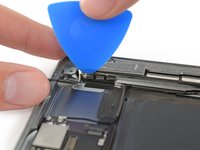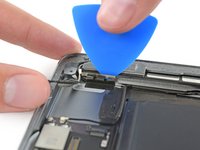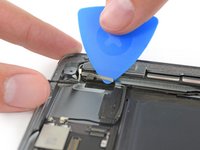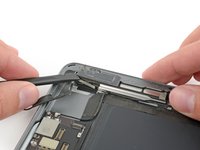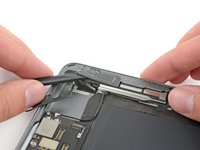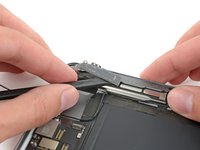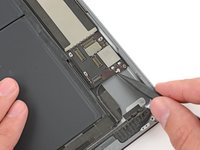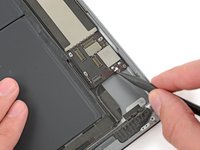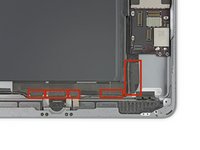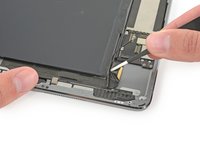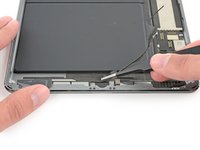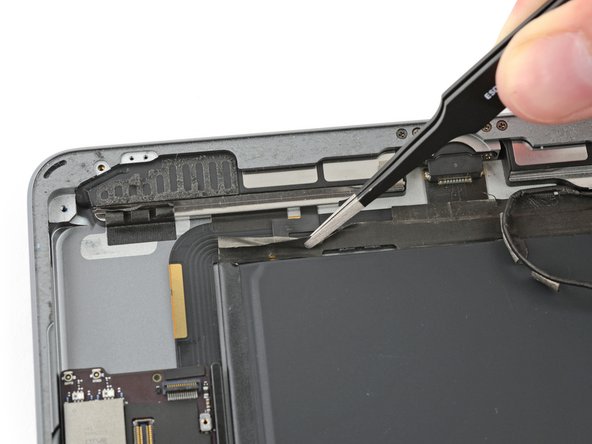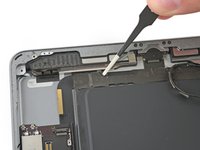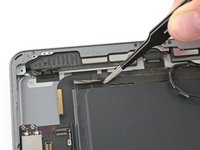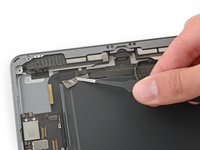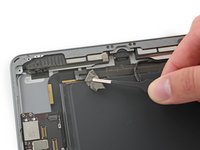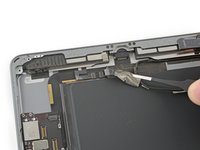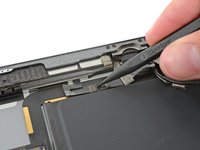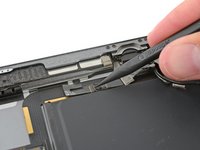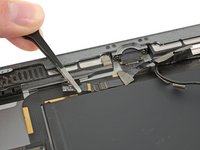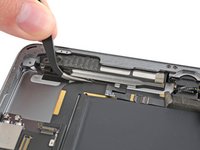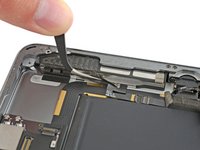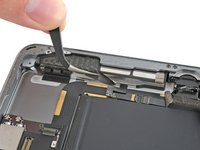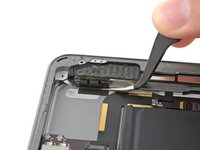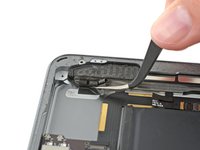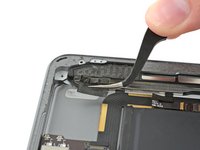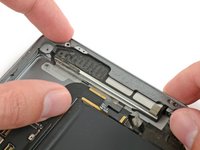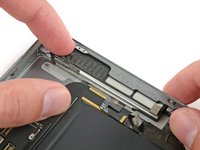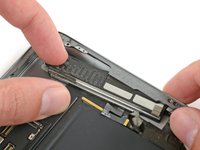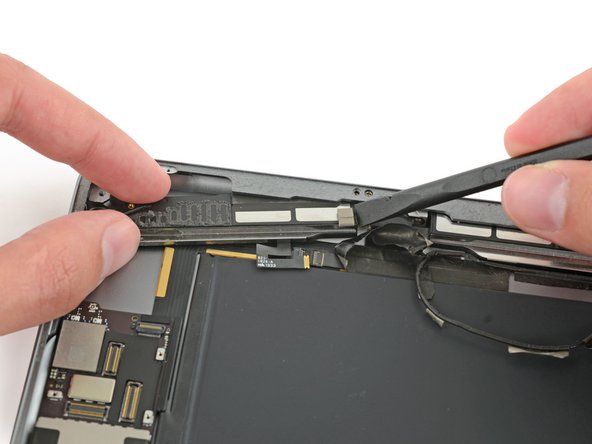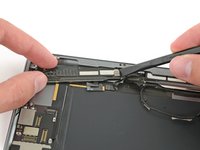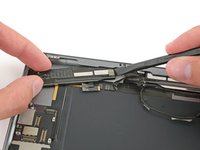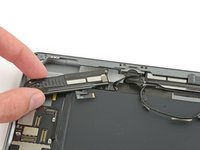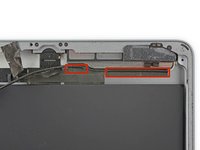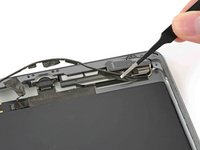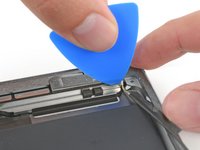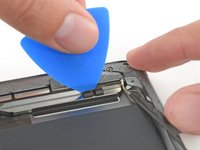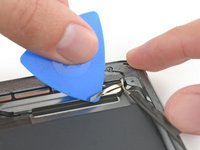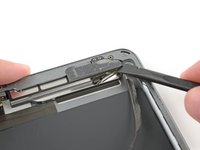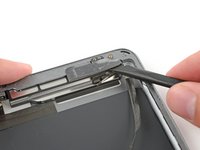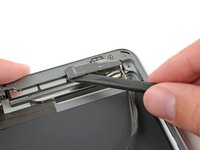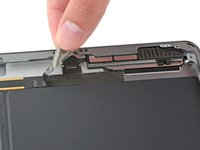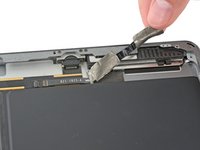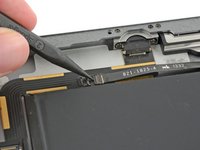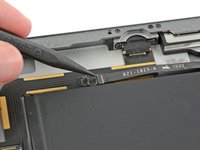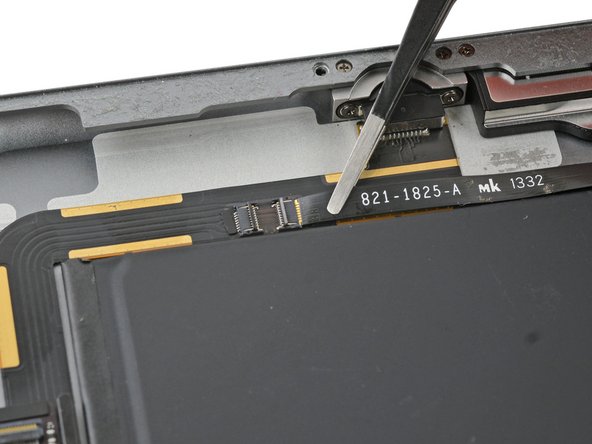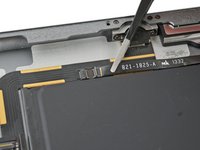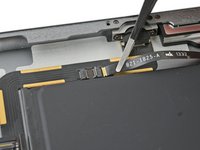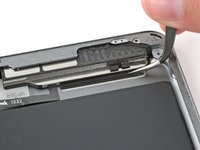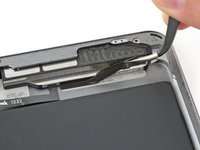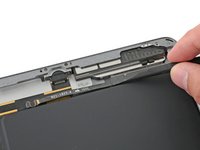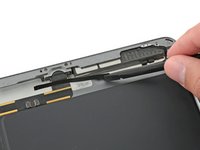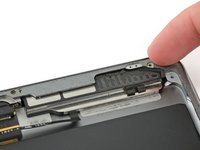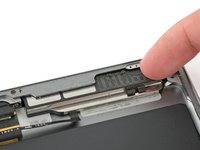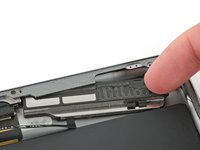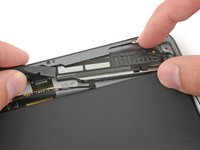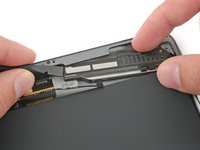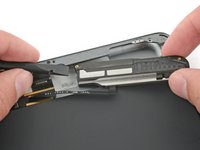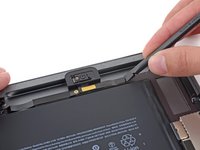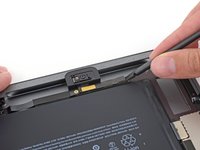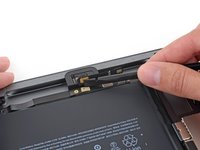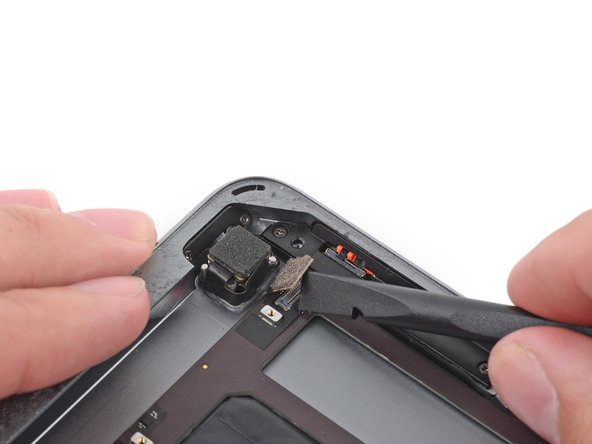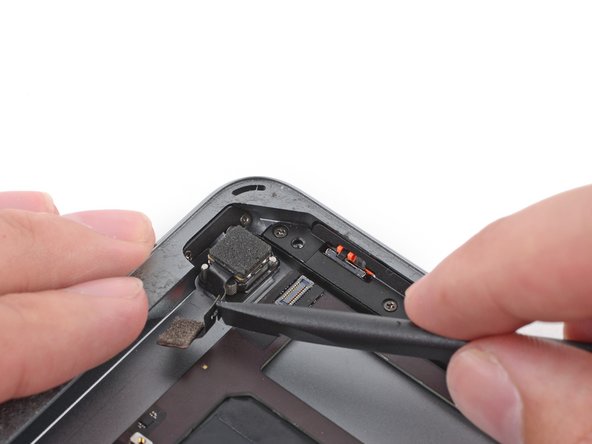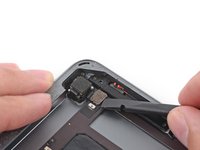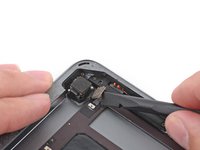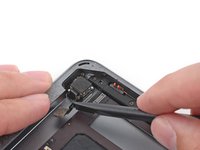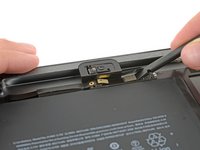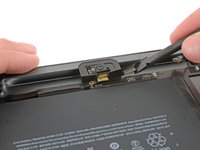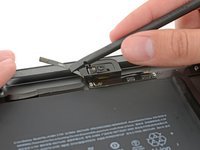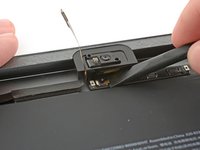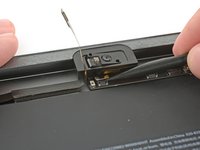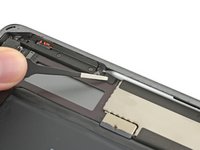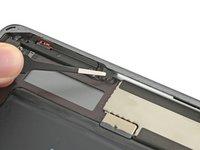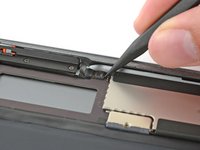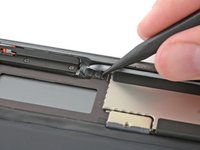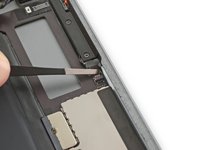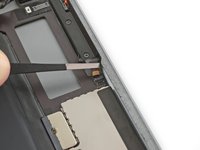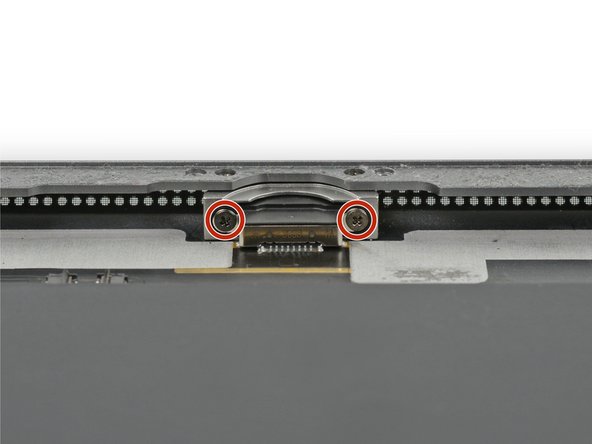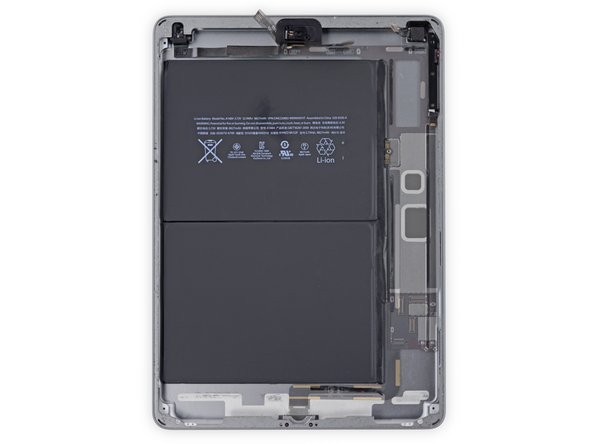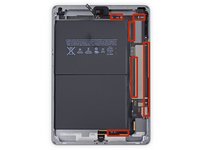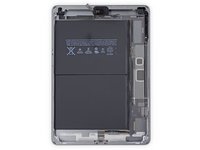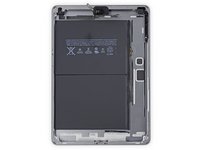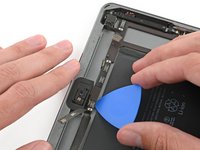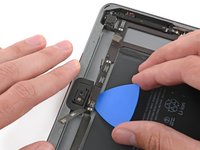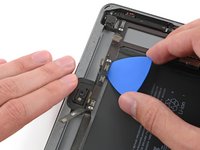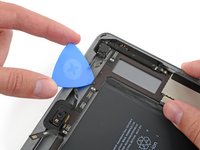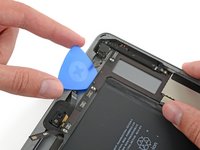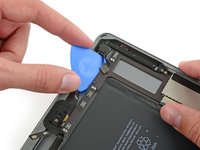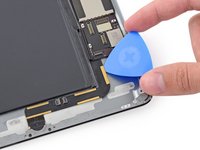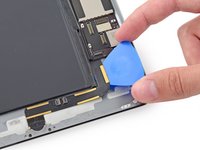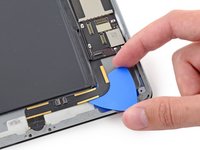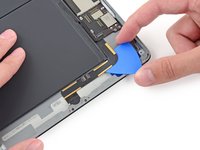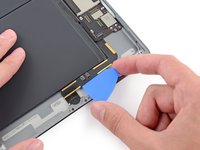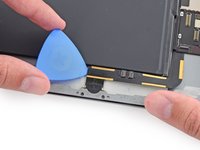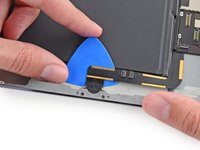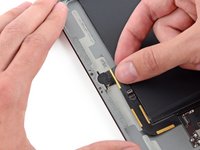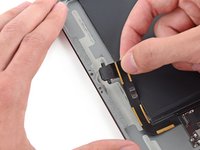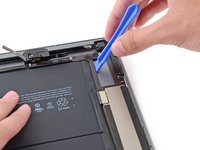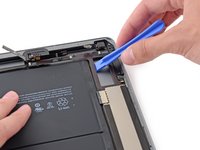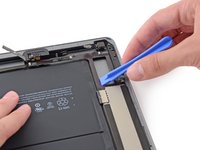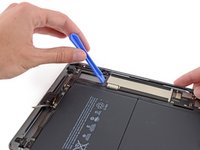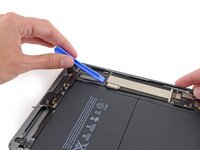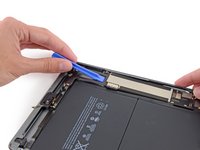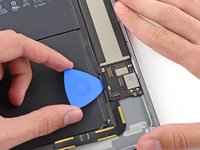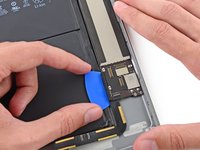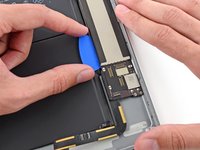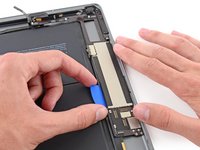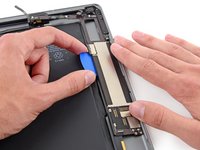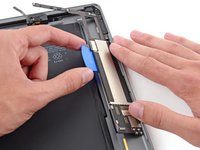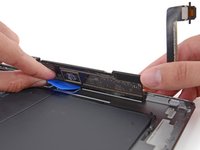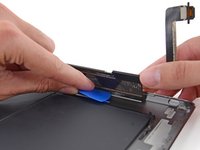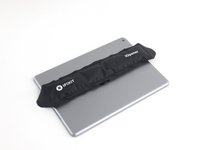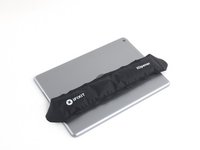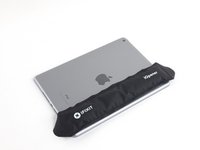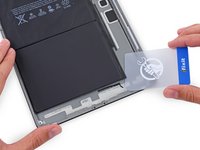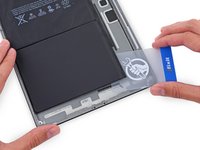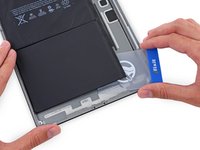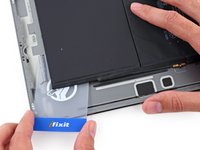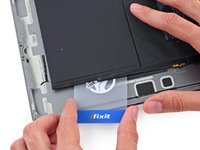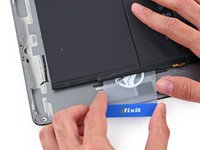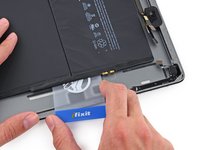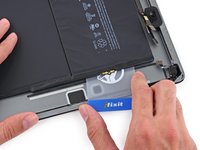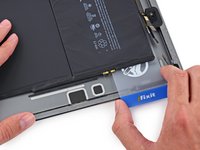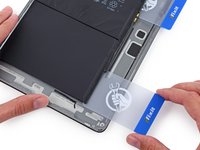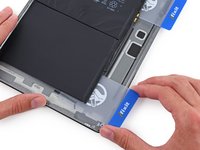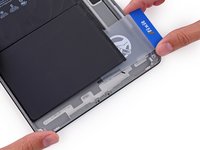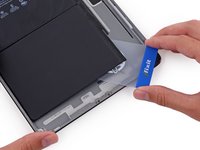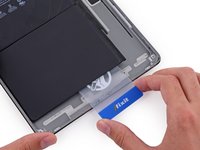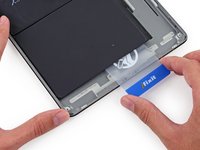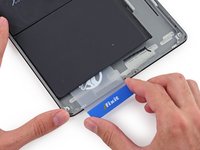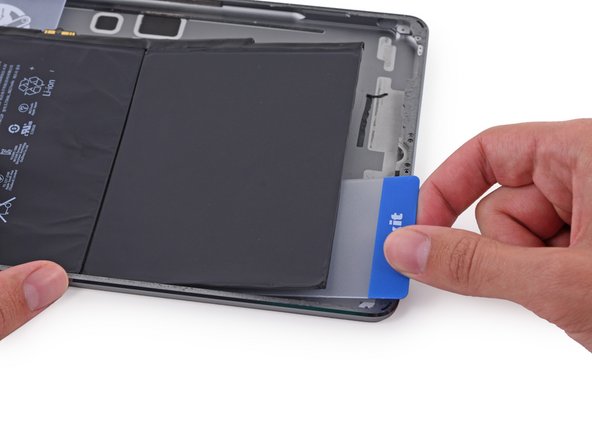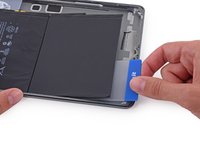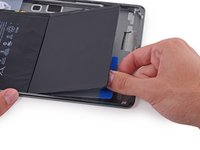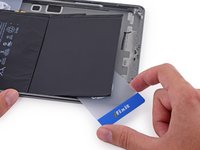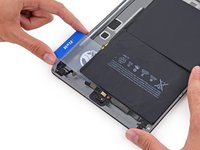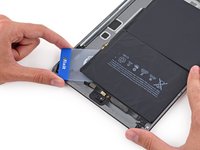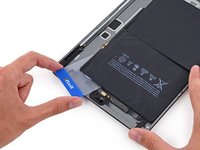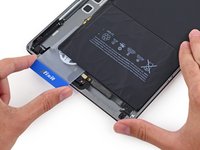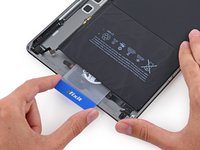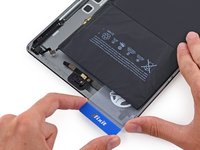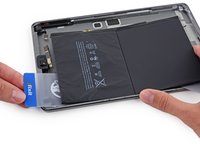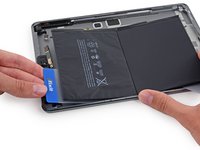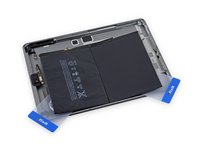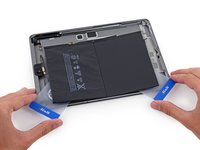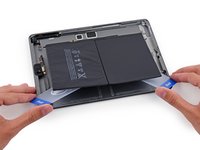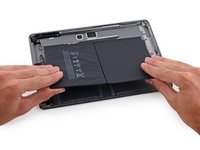Einleitung
Diese Anleitung zeigt, wie der Akku im iPad 5 WiFi ausgetauscht werden kann.
Sei äußerst vorsichtig, wenn du den Akku mit einem Akkublocker abtrennst. Die Akkukontakte können dauerhaft beschädigt werden. Wenn du aber weiterarbeitest, ohne den Akku zu isolieren, dann vermeide den Gebrauch von Metallwerkzeugen, außer wo unbedingt notwendig (z.B. um Schrauben zu entfernen). Dadurch beugst du einem Kurzschließen des Akkus und der empfindlichen Elektronik vor.
Was du brauchst
-
-
Erhitze den iOpener für dreißig Sekunden.
-
Im Verlauf der Reparatur kühlt sich der iOpener wieder ab. Erhitze ihn dann noch einmal für dreißig Sekunden.
-
-
-
Halte den iOpener an einem der flachen Enden und vermeide die heiße Mitte, während du ihn aus der Mikrowelle nimmst.
-
-
-
Fülle einen Topf oder eine tiefe Pfanne mit ausreichend Wasser, um den iOpener komplett damit bedecken zu können.
-
Erhitze das Wasser (ohne den iOpener) bis es kocht. Schalte die Wärmezufuhr (Platte) aus.
-
Lege den iOpener für etwa 2-3 Minuten in das heiße Wasser. Stelle sicher, dass der iOpener komplett mit Wasser bedeckt ist.
-
Nimm den iOpener mit einer Küchenzange aus dem Wasser heraus.
-
Trockne den iOpener gründlich mit einem Küchen- oder Handtuch ab.
-
Der iOpener kann jetzt verwendet werden. Solltest du den iOpener erneut erwärmen müssen, erhitze das Wasser nochmal bis zum Siedepunkt, schalte die Wärmezufuhr aus, und lege den iOpener wieder für 2-3 Minuten vollständig in das Wasser.
-
-
-
Wenn dein Touchscreen gebrochen ist, vermeide weitere Brüche und verletze dich nicht beim Berühren des Glases.
-
Klebe Paketband über den Touchscreen des iPads, sodass die ganze Oberseite bedeckt ist.
-
Bitte befolge die restliche Anleitung wie beschrieben. Wenn das Glas einmal gebrochen ist, wird es während der Reparatur weiter brechen. Eventuell benötigst du einen Metallspatel, um das Glas zu entfernen.
-
-
-
Lege den erhitzten iOpener auf die lange Seite links des Home Buttons.
-
Lass den iOpener für mindestens eine Minute liegen, um den Kleber zu erhitzen und zu lösen.
-
-
-
Wenn du die einzelnen Schritte ausführst, pass besonders an folgenden Stellen auf, wenn du das Glas entfernst:
-
Frontkamera
-
Antennen
-
Display und Touch Screen Kabel
-
-
In diesem Schritt verwendetes Werkzeug:Clampy - Anti-Clamp$24.95
-
Drücke den blauen Griff zurück, um die Arme zu entriegeln.
-
Lege das iPad so auf einen Gegenstand, dass es waagrecht auf gleicher Höhe zwischen den beiden Armen liegt.
-
Bringe die Saugheber mittig nahe an der linken Kante des iPads an, einen auf der Vorderseite, den anderen auf der Rückseite.
-
Halte die Anti-Clamp unten gut fest und drücke fest auf den oberen Saugheber, damit er sich festsaugt.
-
-
-
Drücke den blauen Griff vorwärts, um die Arme wieder zu verriegeln.
-
Drehe den Griff eine volle Umdrehung im Uhrzeigersinn, bzw. so weit, bis du merkst, dass sich die Saugheber dehnen.
-
Achte darauf, dass sich die Saugheber weiterhin gegenüber stehen. Wenn sie sich nicht mehr gegenüber stehen, dann löse die Saugheber ein wenig ab und schiebe sie in die richtige Position.
-
-
-
Warte eine Minute, damit sich der Kleber allmählich ablösen kann und sich ein Spalt bilden kann.
-
Wenn das Display nicht heiß genug ist, dann erwärme die linke Kante des iPads mit einem Haartrockner.
-
Wenn der Spalt groß genug ist, dann setze ein Plektrum unter das Display ein.
-
Überspringe die nächsten zwei Schritte.
-
-
-
Befestige einen Saugheber auf der linken Seite in der Mitte des iPads.
-
Drücke den Saugnapf flach auf den Touch Screen.
-
Halte das iPad mit der einen Hand fest und hebe mit der anderen vorsichtig den Touch Screen vom Gehäuse.
-
-
-
Platziere den Opening Pick in dem entstandenen Spalt.
-
Löse nun den Saugnapf vom Touch Screen.
-
-
-
Platziere nun einen weiteren Pick in dem entstandenen Spalt und ziehe diesen zur unteren Ecke. Dabei sollte sich der Kleber lösen.
-
-
-
Führe den Pick an der Seite des Displays entlang, um den Kleber zu lösen.
-
Wenn der Pick am Kleber festhängt oder stockt, dann "rolle" den Pick an der Seite entlang, um den Kleber weiter zu lösen.
-
-
-
Führe nun den ersten Pick hinauf bis zur oberen Ecke des iPads.
-
Siehst du den Pick durch das Glas? Keine Panik – ziehe es einfach wieder etwas raus. Meistens wird dadurch nichts beschädigt. Versuche dies aber zu vermeiden, weil der Kleber sonst das LCD oder Glas berühren könnte und sehr schwer zu reinigen ist.
-
-
-
Erhitze den iOpener erneut und platziere ihn auf dem oberen Rand des iPads über der Frontkamera.
-
-
-
Schiebe das Opening Pick um die obere linke Ecke herum, damit der Klebstoff gelöst wird.
-
-
-
Ziehe das Opening Pick entlang der oberen Kante bis kurz vor die Frontkamera und halte dann an.
-
-
-
Ziehe das Opening Pick leicht heraus und schiebe die Spitze sehr vorsichtig am oberen Rand des iPads auf Höhe der Frontkamera entlang.
-
-
-
Lass das Opening Pick gleich hinter der Frontkamera stecken.
-
Nimm ein zweites Opening Pick und setze vor der Frontkamera erneut an. Nun schiebe das Opening Pick in die linke Ecke, um den Klebstoff an diesem Rand vollends zu lösen.
-
-
-
Nun kannst du das erste Opening Pick wieder tiefer hineinschieben und von der Kamera weg bis in die Ecke ziehen.
-
-
-
Behalte die drei Opening Picks in den Seiten des iPads an denen der Kleber schon gelöst wurde, sodass dieser sich nicht erneut verklebt.
-
Erhitze den iOpener und platziere ihn auf der letzten unbearbeiteten Seite.
-
-
-
Schiebe den Opening Pick in die obere rechte Ecke des iPads, um den Kleber dort vorsichtig zu lösen.
-
-
-
Führe einen neuen Opening Pick in das iPad ein und schiebe ihn in die Mitte der rechten Kante des iPads, um den Kleber der Kante entlang zu lösen.
-
-
-
Lasse die Opening Picks an Ort und Stelle und lege den erneut aufgewärmten iOpener auf die Seite des iPads mit dem Home Button.
-
-
-
Schiebe den unteren linken Opening Pick in die untere linke Ecke, um den Kleber auf dieser Ecke zu trennen.
-
Lasse den Opening Pick in der Ecke. Gehe damit kein Stück weiter und entferne nicht den Opening Pick aus dem iPad.
-
Die folgenden Schritte führen dich so, dass du Schäden an den Komponenten vermeiden wirst. Verwende Hitze und Hebelwirkung nur da, wo es von dir in der Anleitung verlangt wird.
-
-
-
Schneide mit einem neuen Opening Pick vorsichtig über die linke Antenne, stoppe kurz vor dem Home Button.
-
Lasse den Opening Pick an Ort und Stelle und springe zum nächsten Schritt.
-
-
-
Nimm ein neues Plektrum und schiebe es an die Stelle des vorherigen Plektrums.
-
Fahre am Home Button und der rechten Antenne nur mit der äussersten Spitze des Plektrums entlang, um den Kleber zu entfernen.
-
-
-
Wenn der Kleber gelöst ist, kannst du das Plektrum in der Nähe der rechten Ecke einsetzen. Schiebe das Plektrum nach links und halte kurz vor dem Home Button an.
-
-
-
Erhitze den iOpener und lege ihn auf die Seite der Lautstärketasten des iPads.
-
-
-
Auf der den Lautstärketasten gegenüberliegenden Seite solltest du ein Plektrum in jede Ecke eingesteckt haben. Drehe die Plektren um die Scheibe leicht an zu heben - so löst du auch den letzten Kleber entlang der Kante mit dem Displaykabel.
-
-
-
Hebe langsam und vorsichtig das Display an, um den Kleber entlang der Kante mit dem Displaykabel zu lösen.
-
-
-
Während du das Front Panel Glas hebst, nutze ein Plektrum, um auch den letzten Kleber zu lösen.
-
-
-
Wenn erst einmal jeglicher Kleber entfernt bzw. gelöst wurde, kannst du die Frontglasscheibe wie eine Buchseite öffnen und auf die Arbeitsfläche ablegen.
-
-
-
Entferne die folgenden Kreuzschlitzschrauben, die das LCD befestigen:
-
Drei 4,0 mm Schrauben
-
Eine 4,8 mm Schraube
Use the provided replace screen case's square compartments to place your screws into as you remove them. Really helpful and you likely won't mess up.
I tape a stripe of double sided tape on my workbench. You can place the screws on the tape on the location where the screw would be if it was in the screen assembly. In this step, your screws would be in the four corners of the tape stripe, with the longest screw (4,8mm) in the upper left corner. The other screws from the next steps can also be placed on the tape this way.
**I believe you mean the “top Right corner” Is where the longer screw goes.. not left.
! went to Office World bought 4 packs of bluetac stuck them on a sheet of paper to give approximately size and shape of iPad put it in a flat cardboard box
Where can I buy these screws please ?
-
-
-
Benutze das flache Ende eines Spudgers um das LCD aus seinem Bett zu lösen. Hebe grade soweit an, bis du es mit den Fingern greifen kannst.
-
Klappe das LCD um wie die Seite eines Buches, hebe es in der Nähe der Kamera an und Klappe es in Richtung des Home Buttons auf die Rückseite.
-
Lege das LCD auf seine Vorderseite, um an die LCD-Kabel heranzukommen.
Got a cracked screen from toddler stepping on the iPad. My repair went well, everything worked. Except I scratched the LCD. It seems to scratch easily.
At this step, be careful when folding over the screen, as it may scratch on the aluminum frame (third picture). When they say “soft lint free surface” that is needed, specifically where the LCD meets the frame. Place a thin cloth like sunglass cleaning cloth over the edge of the frame.
Thank you, very much, for this tip.
At this step, possibly depending on date of manufacture, there may be black silicone present on/around the four screws that mount the display. It needs to be carefully scraped away and the two screw mount holes at the top of the screen pried up and away from the chassis. Between the chassis and the plastic portion of the mounting frame, there is a slim sheet of metal. Be sure to pry this off WITH the mounting frame. It is part of it. DO NOT try to separate it.
-
-
In diesem Schritt verwendetes Werkzeug:Battery Blocker$3.99
-
Entferne die einzelne 2,3 mm Kreuzschlitzschraube , mit der der Akkustecker am Logic Board befestigt ist.
-
Schiebe ein Akkutrennstück unter den Bereich mit dem Akkustecker auf dem Logic Board, und lasse es dort während du arbeitest.
-
Wenn es schwer fällt, das Akkutrennstück unter das Logic Board einzusetzen, dann probiere, den Akku mit einer Spielkarte abzutrennen.
Not having the isolation pick, I used 2 thin guitar picks instead, which did the job fine.
I couldn't disconnect the battery connector - I applied some force, nothing happened and I was afraid of applying too much force - so I just left it connected and I was very careful not to short out any terminals with metal tools. I completed the repair without any other issues and the iPad now seems to be working fine.
Mine was missing. Made one with scissors but still didn't do the trick. I just worked with the batteries still plugged in.
Couldn’t get the battery terminal disconnected so I continued with repair. I didn’t short anything but now it won’t do anything. It worked before, just a cracked glass to replace. Any solutions?
Why do you say you didn’t short anything? Your result would seem to suggest otherwise
I don’t know if it applies to the iPad Air, but I saw elsewhere in my researches in reference to a iPad mini (or was it an iPod mini?) that disconnecting the LCD and/or digitizer with the battery still connected will blow a “fuse” for the backlight. Might yours still be working, just with no screen illumination whatsoever? Dunno. Just a thought.
It apparently can be repaired, but is no longer a DIY job.
Tim -
try lifting the board and not blocking the connector. If you block the connector there are pins that could be damaged.
A replacement of the battery connector is required if pins are bent should you get power on or charge issue after battery disconnection. This can be replaced with the right tools and low melt solder to remove the connector and replace.
Best method to disconnect battery is to carefully lift the logic board near the battery connector enough to slip a piece of thin plastic or paper between the batter connector and the logic board battery connector and pins.
Failing to isolate battery so can result in blown back light or touch filters or diodes in backlight circuit.
At the very least run down the battery flat prior to repair but you are really best to isolate battery.
From a repair point of view. This connector is a royal pain. For assembly it's great, well, nearly great.
This connector is SOLDERED to the motherboard side. Never lever this on the motherboard side, I will call it the right hand side. It will break leaving it's soldered pins behind. Yes I did it.
The pins, on the battery side of this connector, just rest on the batteries plated pads. They are kept under tension by the screw. It should be noted though that removal of the screw will not disconnect the connector pins from the battery pads. Natural tension is still present.
I suggest strongly that you take a look at the battery connector online to see the nature of the pins and you will see that some are quite delicate.
The tools purpose is to raise the battery side of the connector ; the left side, so there is some clearance between the pins and the batteries pads. If you have seen a picture of this connector then you will realise the potential of damage to this connector and will have a better idea of what to do.
Contd.
Lifting the connector and simultaneously sliding a thin piece of card or plastic under the pins should be done carefully. In fact, to minimise damage I just slid it under ONE of the main battery pins, plus or minus, which are in the middle and quite robust compared with the tiddlers on the side of the connector.
The second point, the battery and the motherboard have protection circuitry. When I broke my connector the battery dropped to 0.5V at the terminals. Connecting the charger, when all the connections were sound and not shorted raised it from the dead back to over 3.2V
I replaced the battery, and got things hooked backup. For the test, the screen came on, digitizer seemed to be functioning fine. But I couldn’t get it to charge. I used the i-fixit battery blocker by using my spooger to put a little up pressure on the board, and then sliding the blocker in. I don’t think I damaged the pins, but its possible. This is a friends ipad, and its obviously been dropped a few times. I started eye balling the charging port, it LOOKS ok, but looks can be deceiving. When plugged in, even trying different cables, the ipad is not showing the charging symbol. Some of the comments here seem to imply, if I damaged the battery connection pins, I would still get a charging symbol. My question is, if I damaged those battery connector pins, would the ipad show the charging icon or not? Should I be looking at replacing the charging port?
-
-
-
-
Entferne die drei 1,4 mm Kreuzschlitzschrauben von der Halterung des Displaykabels.
Be careful when re-installing screws on reassembly. I mistakenly put the longer screw from the battery connector in the outboard hole, and wound up twisting off the lug that is only lightly soldered to the metal below. Still have 2 screws and system seems to work fine.
-
-
-
Mit dem flachen Ende eines Spudgers kannst du ganz vorsichtig die Halterung des Displaykabels senkrecht aus der Hauptplatine heben.
bough my digitizer from ebay and have everything done up to this step. The screwdriver the kit came with said to be a #000 but it stripped the screw on the plate... I have tried rubber bands, tape and paper to no avail...anyone got an idea on how to remove the screw. Also I am currently studying in St. Kitts and they lack some products found in the US.
I'm sure you've moved past this by now, but I've had some success with stripped screws using a comparable, if slightly larger flathead screwdriver. The screwdrivers that come in those kits tend to suck quite a lot... iFixit actually has a guide for stripped screws: Wie man eine rundgedrehte Schraube entfernt
-
-
-
Entferne das LCD.
Andddddd continue this iFix folks! It's not a matter of working backwards. Most people must have cracked screens and end up having to rip the screen off and won't have a chance to inspect connections.
He is far from complete…..if lcd is being replaced its probably because top screen is busted too. He didn’t show anything about how to remove the cables for that.
There is a separate guide for replacing the outer glass ;)
-
-
-
Entferne vorsichtig das Klebeband, welches den Anschluss des Home Buttons schützt.
I totally skipped steps 39-98 I didn’t see any need to remove all these components and the logic board just to get the battery out. I gently pried up the board where the battery connector goes in, slipped it out, and slipped in the new one.
That is a great tip. There is plenty of space inside the case to lever out the battery without taking out all of the components. I laid the iPad on top of a large bean bag, heated for 3 minutes in the microwave. After 4-5 minutes, I was able to lever out the battery with the spudger and the credit cards. It came out after a few minutes of careful levering and cramming the credit cards under the battery. I unscrewed the earphone connector and carefully taped it back to the iPad housing with paint tape to have more room to maneuver.
I second this.
Just be careful to make sure you don’t squish or tear any wires or anything else surrounding when you’re fighting with the batteries, and it’s still way easier than removing everything else in there first.
I’ll add one bit, though. The hole in the battery connector that accepts the screw through the logic board also apparently slips over a pin in which the screw seats. I couldn’t see that. So when I got the last bit of battery adhesive to let go, the pin tore out the battery connector hole. Since I was replacing the battery, it wasn’t a problem, but did produce a little conductive piece that I had to fish out before putting anything back together. Wouldn’t want that little torn out piece running around in there to short something out later.
Also, that pin will locate the battery correctly, so that in one of the last steps of reassembly, the battery connection screws together properly. Make sure you find it before the battery adhesive grabs on to the back of the case.
Tim -
Careful removing the tape. The home button has a zif connector and if you aren’t careful the tape can rip the zif flap right off. You might have to hold it down while you pull it off or pull the tape from a different direction to make sure you dont tear the zif tab off.
-
-
-
Nutze die flache Seite des Spudgers, um die Abdeckung des ZIF-Anschlusses zu öffnen.
-
Entferne jetzt das Kabel aus dem Anschluss, indem du vorsichtig und gleichmäßig in horizontaler Richtung daran ziehst.
I got through the repair, only to have the new screen give me problems that I can not find solutions to any where. The digitizer is working on its own without my input, it will start apps, switch windows, etc. I have pulled up the new screen and checked my ribbons and cables seem to be fine. ANY IDEAS??
Moses Roman
Same exact problem that I have. I think it has something to do with the glass touching the ipad. Something like on the iPad mini, where you had to cover some areas beside the home button.
I would love to see a real solution, as im stuck with unhappy customers and frustrated me :)
I had mine replaced TWICE by a local repair shop. Soon noticed both times that the iPad would soon go haywire after a few minutes use with random clicks, ghost typing, opening apps, etc.
The iPad Air's such a poor quality, un-durable product anyway. I only had my screen replaced in the first place because it cracked with no apparent drop or trauma and Apple wouldn't replace.
I have also the same issue, does anyone know what the problem is?
Please give us some feedback.
Have seen this with multiple repairs where the digitizer was replaced. In each case it was a problem with the digitizer cables where it gets tucked under the glass near the edge of the frame. Not yet sure if they are badly made digitizers or if the cable gets damaged trying to tuck it under frame during installation.
To avoid the digi sending the ipad crazy. In the same way you tape the copper/silver edges on the back of the glass for the iPad Mini. You tape all the way around, making sure not to dirty the protective cover when placing back down after taping one edge.
Make sure all the metal surround is cover by tape, but careful not too go over the edges too much. It will be visible when using the device.
Like i said earlier, the real skill is not too dirty the screen when lifting the protective sheet.
Have fun!
Thanks man, I'll give it a try. Any idea what kind of tape should I buy?
Kapton tape otherwise known as heat tape or polyamide tape
Just fitted the screen, the digitizer works, display all good but I had a message saying I could not use touch ID and the home button doesn’t work at all…is this expected?
I break the ZIF connector. Is tat touch connecter.?
How do you take the ribbon cable off from the home button site???
-
-
-
Nutze die flache Seite des Spudgers (oder einen Fingernagel), um die beiden Digitizer-Kabel vom Logic Board zu lösen.
What are those connectors for because i kinda half broke the left one on the screen on the glass frame and now the lcd wont turn on
-
-
-
Löse vorsichtig das Home Button Kabel aus der Verklebung, die es am Gehäuse fixiert.
THIS PICTURE IS PERFECT AND PERTANANT TO THE NEXT STEP REGARDING “GHOST OR PHANTOM TOUCH” - See that foam around the edges? For some reason, the ifixit replacement digitizer doesn’t come with it (but it does come with new adhesive applied already.) With your screen, also purchase their “tesa tape” : Tesa 61395 Tape / 4 mm - it comes in different widths fyi. I choose 4mm as advised by a staff member.
On the replacement screen I received from you, the home screen ribbon cable does not fully seat inside the Zif connector like the original and will not lock in place as a result. It seems too fat. Any tips to make it work?
I can’t think of any reason for that other than it’s the wrong display for your model, or it’s defective. Double-check the model very carefully and make sure you ordered/received a compatible part. If you ordered from iFixit, contact customer support directly for returns or exchanges. Good luck!
I didn’t receive any of the two sided tape…I assume it needed to be ordered separately??
So, when I removed the glass, the bottom cable tore and I have to replace it. The video is not as clear regarding replacement. The old button had a round rubber gasket but the new one does not. No inst. how to re-use it. I can’t attach and keep in place the new button.
In a previous repair, i broke the zif, what you want to do is hold it down while removing the tape, otherwise it will pull the parts up with it.
Since it was broke i put a piece of electrical tape on top for the pressure the zif would push down, then another piece from the screw hole to the bend in the cable, so it does not come loose when putting back together.
-
-
In diesem Schritt verwendetes Werkzeug:Polyimide Tape$9.99
-
Entferne nun das Frontglas.
-
Wenn du Probleme mit dem neuen Touchscreen des iPads durch Phantomauslöser hast, kannst du an den markierten Stellen auf der Rückseite sehr dünnes Isolierklebeband befestigen, so wie z.B. unser Kaptonband (Polyimidband). Ersatzteile von iFixit sind schon mit geeigneter Isolierung versehen, bei ihnen sollte das nicht nötig sein.
In your conclusion, which doesn't have a comments area, you say to reverse the procedure - simple enough, BUT what about the sticky adhesive residue along the edges of the (a) the just-remove-glass (if re-using) and (b) along the 'inside' edges of the iPad chassis? Typically Apple says to remove the adhesive residue (careful) with alcohol wipes (lint free & 98% isopropyl). Thanks for the instructions!
the hardest part of this repair for me is actually aligning the ribbons (especially on the aftermarket version) so they don't jumble and cause the glass to mush away from the adhesive leaving a gap. Would would be very helpful to see how to fold the ribbon cables back on the aftermarket digitizers. They are slightly different than the originals, or at least they appear different. This repair is super useful but we could really use a step 44 because re-assembly has a sequence and a folding technique.
The ribbon cable is a little tricky to figure out. But if you look closely at the old ( Broken) screen you will see they stick to the underside of the screen thin the remaining ribbon slides down into the ipad between the display and ipads frame.
I used a heat gun and suction cups to loosen screen.
This was a very good ifix ii
This is what I need too!
It is not as simple as reverse disassembly steps, the ribbon cables need to be tucked into the pocket on the side of the iPad. There is tape on them that has to adhere to the side of the digitizer too. Mine did not make it all the way down into the gap, and stuck on the other adhesive, now I have a gap by these two cables. To tuck these into this area is difficult at best. I now need to remove the glass, hoping it does not shatter and purchase more tape.
Other than this the task was not bad.. BTW: YES People use the capton tape
I’ve read that people are putting glue at each corner. I haven’t figured out what glue. One person said Glue Dot 1” 16lb, another said rubber cement, 1 video shows 5 min epoxy… Heard that some sort of glue (not super glue) needs to be used to avoid the glass lifting later on. And to use 3m red tape along the edges. I’ve been searching for which glue because I still have an ipad air to do screen replacement on.
Would be helpful if the tape were listed in the master supplies for the guide. I got the whole kit overnighted, but then had to wait a week to get the tape from Amazon (since I wasn’t going to shell out another $50 for overnight shipping). Otherwise, it’d be nice to know if the displays through iFix it included the foam or not—mine didn’t.
Second the concern about the foam. I bought the full repair kit, but was surprised there wasn’t already polyimide tape on the digitizer or in the kit. At least mention that it needs to be purchased extra.
@baron9 The displays we sell have the proper insulation and don’t require any tape. That note is more for folks who use our guides while buying the parts from somewhere else. (They tend to complain here, even though it’s the part that’s at fault, not the guide.) I’ve updated the instructions to try to make things a little more clear. Sorry about that!
My digitizer kit from ifixit also looks like it is missing the polyimide tape on the digitizer. Can someone confirm that i do not need to get the tape with the original ifixit kit and just slap the digitizer on there?
Alex -
I did not realize that aftermarket screens (besides the one ifixit sells) do not come with adhesive strips. Well worth the time to figure out what kind of adhesive you’re going to use to re-adhere the glass before you begin. Stopping while you’re so close to the end of the repair (or having to open the ipad up again after the screen doesn’t stick back down) is slightly frustrating.
I used a b-7000. 48 h cure time.
Just wanna say thank you. I replaced my LCD and digitizer today…. took a LOT longer to get that adhesive off than I expected. And the IOpener busted in my microwave despite following all directions (eg only 30 sec at a time, out for at least 10 min before reheating. So that sucked. Turns out the rice in a sock worked pretty well too.
Regarding assembly: even with carefully tucking the ribbon cables down the side while reassembling, it’s still hard to get that area to stick down.
Some advice when reassembling that I have learned in the hard way.
One good hint is to those who buy replacement parts that are not exactly the original ones. Some of the parts come with a 3M adhesive tape on the tab of the flex cables (I guess original parts are already folded and glued). I would strongly recommend to be very careful when you try to glue it on the front panel and maybe watch a video on how to fold it properly, so as not to fold or pinch the flex cable on an unrepairable way. Also, some of the low cost parts come with a very strong protection sticker on the front glass. It is advisable that you peel off the sticker before reassembling the ipad in order to not end up ruining the glue that was supposed to hold the front panel .
-
-
-
Schiebe einen Spudger unter das Antennenkabel nahe dem Rand des iPad und hebe es hoch, um den Verbinder des Antennenkabels zu lösen.
Skip to the step 98 or even 100 if you just need to replace the power button - I think you should even consider this to replace volume buttons. I am fixing mine right now and screwed up the speaker cable. I did follow the instruction but totally missed the cable right below the tape. I proceeded further, but I just realized I didn't have to go through all the troubles. I wish ifixit.com can manage this type of direction clearly so that dis-assembly is minimum.
After you replace the Digitizer if you are getting random key presses it is likely to be because Kapton tape has not been applied to the edges of the digitizer. You need to cover the silver strip around the edge of the digitizer with kapton tape before reassembling. Works every time.
This is my first ipad and when the battery dies, it will be my last, way overrated and no options like memory cards or mini usb ports, and the battery thing is ridiculous,I wish I would have never bought this knowing this stuff , and way over priced.
It always helps to Google something before buying it. "iPad Air reviews" in Google would have saved you. I just find it funny how in this day and age, people STILL make "purchase mistakes" because they didn't take the time to research the several-hundred-dollar device they are about to commit to purchasing. You should have seen the amounts of research I did before buying my $1,399 Asus G751JY laptop. I'm absolutely pleased with it and am happy I don't deal with issues other people have. Just be weary, buddy. ALWAYS GOOGLE.
Scott S -
If you just want to replace the battery, skip to step 99. You can easily get to most sides of the battery without removing all other components. It worked for me. Good luck!
I wish I read this comment. Would have saved me a lot of time.
leo -
I followed your piece of advice and went to step 99. My new battery works just fine without removing all those components including the logic board - thanks a lot!!
An important note - as per the comments lower down, you can skip ahead to step 95 (unsticking the battery) just fine if you're just changing the battery, but after you've unstuck the battery you will need to go back to step 88 and soften the logic board adhesive so you can pry it up about a cm and lift the battery terminal up and over the post to remove it. I didn't realise the post was there, and broke off a piece of the original battery terminal that got stuck under the logic board. This prevented a good connection with the new battery, and caused random restarts after I put everything back together until I realised and went back to recover it.
Don’t skip to 99 because you need to remove the logic board.
I have successfully replaced the Battery without removing any components other than the Screen Assembly and LCD. You can skip steps 44 thru 99 by using a spudger as a wedge to lift & hold the Logic Board high enough to lift the battery contact over the post that holds it in place… this will save you a lot of time and frustration and makes the repair sooo much easier.
My goal was to replace the battery. As some suggested I skipped some steps. I did Step 46 and left out 47 to 100. But I think Step 46 can be skipped too. iFixit probably does not recommend skipping these steps because it is riskier to bend the batteries and damage them. But if you work carefully enough and make sure the adhesive has been softened well, you should be fine. It was no problem for me. It saved me quite some time. (I will write a comment in Step 102 to help you get the batteries out without Steps 46-100.)
-
-
-
Zwei große Stücke Klebeband sind um das rechte Antennenkabel gewickelt und befestigen es am Gehäuse.
-
Löse das Klebeband vom Gehäuse.
You may partially skip steps 46 to 100, as it is not really mandatory to remove all those parts in order to remove the logic board and the battery.
-
-
-
Setze sorgfältig ein Plektrum zwischen Lautsprechergehäuse und der Klammer am Antennenkabel.
-
Schiebe das Plektrum in Richtung Home Button, um die Klebeverbindung zu trennen.
-
Schiebe die Klammer weg vom Lautsprecher, bis sie das Band darunter freigibt.
The pick was not thin enough but the razor worked.
In my view there is a few destructive steps here. I have been able to remove this entire assembly by lifting only the adhesive tape anchoring it to the back without touching this fine metal bracket as touched in in Step 46 & 63 or tearing the foam in Steps 48 & 65 on both the left & right sides. Remove the screws as in Step 47 & 57 and the one’s either side of the charging port in 64 & 71. Once removed, the only thing securing these to the rear is adhesive tape. Lift the tape and walk the units out by nudging them from side to side.
Thanks. Made the whole next chunk much simpler :)
-
-
-
Entferne die drei Kreuzschlitzschrauben PH000, die die rechte Antenne befestigen:
-
Eine 2,3 mm Schraube
-
Zwei 1,4 mm Schrauben
I would strongly advise not to follow this step and following ones: removing the 2 Wi-Fi antennas is not required for complete disassembly of the motherboard and battery, and you may potentially destroy your antennas: I scrupulously and foolishly followed this tutorial step by step and now I have severe Wi-Fi problems on my iPad because one of the 2 antennas has been damaged during the process (and by reading all the comments on this page you'll see that I'm not the only one to have this issue...).
=> As someone else already mentioned it in the comments, just skip most of these steps and go directly to something like step 79.
-
-
-
Setze das flache Ende eines Spudgers zwischen Antenne und Lautsprechereinheit.
-
Schiebe den Spudger in Richtung Home Button, um den geklebten Schaumstoff, der die Antenne festhält, zu trennen.
Este paso es innecesario, ya que con solo quitar los tornillos es suficiente, no hace falta despegar la goma espuma que mantiene la antena de la bocina.
tout a fais il n'est pas nécessaire de décoller l'antenne du haut-parleur ! Il faut juste enlever les vis et continuer le démontage du haut-parleur en laissent l'antenne fixer a lui !!!
Faire de même pour le deuxième haut-parleur !
-
-
-
Setze einen Spudger unter das linke Antennenkabel und hebe es hoch, um den Antennenkabelverbinder zu lösen.
-
-
-
Das linke Antennenkabel, welches den Verbinder des rechten Lautsprechers verdeckt, ist mit fünf Bändern umwickelt.
-
Löse die Bänder vom Gehäuse ab.
-
Biege das Antennenkabel so, dass es aus dem Weg ist.
This step was not very well explained. It fails to mention the speaker cable attached on to the tape. This caused the speaker cable to be torn since it is so thoroughly attached to the tape. Guide made no mention that it was under there or that you should be careful about it. Not even the usual remove the tape gently they just tell you to rip it right off no problem. Not sure how this was missed when the guide was so thorough about this beforehand.
Approx. 3/4 of an inch past the bend in the cabling underneath the tape lies the right speaker cable. Beyond this point proceed with extreme caution. Delicate cables and ZIF connectors underneath the tape will be torn or damaged if they aren't separated from the underside of the insulation tape first. Use fingernails or thin-edged tools.
An update to this would be nice. Will the Ipad work with a broken spaker cable? Is it possible to get replacement part? Maybe this step should be rewritten.
-
-
In diesem Schritt verwendetes Werkzeug:Tweezers$4.99
-
Stattdessen kannst du das Band direkt unter dem Lautsprecher anfassen und vom Gehäuserand her wegziehen.
-
-
-
Ziehe das Band in Richtung Home Button ab und lege so den Verbinder des Lautsprecherkabels frei.
-
-
-
Hebe die Sicherungsklappe des Verbinders am rechten Lautsprecherkabel mit der Spudgerspitze hoch.
-
Schiebe das Lautsprecherkabel direkt aus seiner [Ungültiger Anleitungslink].
-
-
-
Der Lautsprecher ist mit einer 2,2 mm Kreuzschlitzschraube #000 am Gehäuse befestigt. Drehe sie heraus.
-
-
-
Setze den Fingernagel oder das flache Ende des Spudgers in die Vertiefung am Lautsprechergehäuse in der Nähe der Gehäuseecke.
-
Ziehe den Lautsprecher nach unten von der Gehäuseecke weg.
-
-
-
Ziehe jetzt mit Hilfe eines Spudgers den Lautsprecher unter der Kante des Gehäuses heraus.
-
Entferne den rechten Lautsprecher vom iPad.
When did you remove the blocker after installing the battery blocker? No photos with blockers after this procedure.
-
-
-
Entferne drei 1,4 mm Kreuzschlitzschrauben #000, die die Halteklammer für obere Baugruppen befestigen.
-
-
-
Es gibt noch zwei weitere Klebestreifen, die das linke Antennenkabel am Gehäuse festhalten.
-
Ziehe sie vom Gehäuse ab.
-
-
-
Setze vorsichtig ein Plektrum zwischen Lautsprechergehäuse und der Klammer für das Antennenkabel ein.
-
Schiebe das Plektrum in Richtung Home Button, um die Klebeverbindung aufzuschneiden.
-
Schiebe die Klammer weg vom Lautsprecher bis sie vom Klebeband darunter frei ist.
-
-
-
Entferne folgende Kreuzschlitzschrauben #000:
-
Zwei 1,4 mm Schrauben
-
Eine 2,3 mm Schraube
I didn’t need to take the left antenna and speaker out. If you just get the wire and tape out of the way so you can unplug the speaker flex cables and take out the lightning connector, then you should still be able to get the logic board out. the left speaker isn’t in the way at all.
-
-
-
Setze das flache Ende eines Spudgers zwischen Antenne und Lautsprechereinheit.
-
Schiebe den Spudger in Richtung Home Button, um die Schaumstoffklebeverbindung der Antenne aufzuschneiden.
Este paso es innecesario, ya que con solo quitar los tornillos es suficiente, no hace falta despegar la goma espuma que mantiene la antena de la bocina
-
-
-
Ziehe das Band ab, welches den Verbinder des linken Lautsprecherkabels bedeckt.
-
-
-
Hebe die Sicherungsklappe des Verbinders am linken Lautsprecherkabel mit der Spudgerspitze hoch.
-
-
-
Entferne die 2,2 mm Kreuzschlitz #000 Schraube, mit der der Lautsprecher am Gehäuse festgehalten wird.
-
-
-
Biege das Flachbandkabel zum linken Lautsprecher ganz vorsichtig nach oben, so dass der Akku freiliegt, wenn du das Lautsprechergehäuse herausschiebst.
-
-
-
Setze den Fingernagel oder das flache Ende des Spudgers in die Rille des Lautsprechergehäuses in der Nähe der Ecke des Gehäuses des iPad.
-
Schiebe den Lautsprecher nach unten und von der Gehäuseecke weg.
-
-
-
Ziehe den Lautsprecher mit Hilfe eines Spudgers unter der Kane des Gehäuses hervor.
-
Entferne den linken Lautsprecher vom iPad.
-
-
-
Löse den Verbinder der Frontkamera mit dem flachen Ende des Spudgers vom Logic Board.
-
Biege das Kabel der Frontkamera aus dem Weg.
-
-
-
Löse den Verbinder der Rückkamera mit dem flachen Ende des Spudgers vom Logic Board.
-
Biege das Kabel der Rückkamera aus dem Weg.
-
-
-
Löse den Verbinder der Kopfhörerbuchse mit dem flachen Ende des Spudgers vom Logic Board.
-
Biege das Kabel der Kopfhörerbuchse aus dem Weg.
Note for others. On this connector, i have some tape keeping it down, it's rather difficult to remove without ripping it. So i ripped the tape to remove it.
"Ripping" the tape seems ill-advised. A sharp ceramic craft paper cutting knife or the very tip of a fine-tip Exacto blade work well. Once the tape is cut on one side, the blade slides through it like it's nothing. Zero force required.
Be careful not to insert a blade too far or it may come into contact with conductive components.
-
-
-
Löse den Verbinder des Mikrofonkabels mit dem flachen Ende des Spudgers vom Logic Board.
-
-
-
Entferne jegliches Klebeband, das den Verbinder zum Kabel der oberen Bedienungstasten festhält.
-
-
-
Hebe die Sicherungsklappe am Verbinder zu den oberen Bedienungstasten mit der Spudgerspitze hoch.
-
-
-
Ziehe das Verbindungskabel zu den oberen Bedienungstasten gerade aus seinem ZIF Verbinder.
-
-
-
Entferne die beiden 3,3 mm Kreuzschlitzschrauben #000, die den Lightning Port befestigen.
NOTE for others who might miss this: this picture is looking down, out the bottom of the iPad. There are four other screws near the lightning port, two for the speakers and two for the port. You see these four easily, looking down at the battery and motherboard. These two are additional to those, and perpendicular to them. Both pairs of lightning port screws, one set perpendicular to the other, must be removed.
Where did the battery blocker go? It was introduced in step 35. Nowhere has it been said it can be removed . . . yet it is now absent in this picture. I took it out when I got to steps 93-96.
Yes this is a deceptive image as the battery and connector strap seem to be missing. Hold your iPad vertically and look down at the lightning port and you’ll see these hidden screws.
Thanks for your comment! I’ll add a note in the step.
-
-
-
Die Klebeverbindung besteht aus sechs Stück Klebeschaumstoffband. Schaue bei der Arbeit immer wieder auf diesen Schritt, damit du weißt, wo sich die einzelnen Klebestreifen befinden.
Thread a piece of dental floss under the tip of the logic board. Be careful when rounding the corner not to snag any ribbon cables. This easily released the foam tape up to the battery connector.
Les 2 images suivantes sont contradictoires. elles donnent l'impression de devoir enlever la carte mère.
@totoy Effectivement, cela peut-être perturbant, mais ces images servent de référence et expliquent où se trouvent les six morceaux d'adhésif qu'il va falloir décoller au cours des étapes suivantes pour retirer la carte mère.
-
-
-
Lege einen erwärmten iOpener auf den Rand mit der Rückkamera des iPad. Lasse ihn dort mindestens eine Minute liegen, um durch das Gehäuse hindurch den Klebstoff aufzuweichen.
-
-
-
Setze sorgfältig ein Plektrum unter das Logic Board zwischen Frontkamera und Akku.
-
Schiebe das Plektrum in Richtung Frontkameraverbinder, und halte an der Biegung im Logic Board an.
-
-
-
Schiebe das Plektrum unter dem Logic Board von der Frontkamera zur Rückkamera.
-
-
-
Setze ein Plektrum an der Stelle an, wo das Lightning Kabel auf das Logic Board trifft.
-
Schiebe das Plektrum weiter entlang und um die Biegung des Kabels.
-
-
-
Fahre fort das Plektrum unter das Kable zu schieben, bis das Kabel sich zur Lightning Buchse hin biegt.
-
-
-
Zum Schluss musst du das Plektrum zwischen Akku und Lightning Buchse einsetzen um den letzten Rest des Klebers unter dem Kabel zu lösen.
There are two screws holding the lightning connector to the rear case, I didn’t see them in this guide. I recommend removing them before you attempt to remove the lightning connector, otherwise you’ll look like an idiot struggling with it for around 1/2 an hour like I just did.
Did you skip this step?
I had this problem too!!
Will Young is correct. The two extra screws are horizontal - they are in addition to the vertical screws mentioned in step 82.
@usablethought AFAIK there are only two screws securing the actual port to the chassis. You can tell by looking at the part—there are only two screw holes. Those additional screws can be left in place, as shown in the photos. At least, that was my experience. If you’re working on a different model, then of course you may need to improvise—the instructions are only for the model indicated.
-
-
-
Ziehe die Lightning Buchse gerade aus ihrem Sitz im Gehäuse.
there were two screws holding the lightening connector in place on my iPad
Yep! In this guide those screws are removed in Step 82, but you can remove them at any point prior to taking out the Lightning connector.
CAUTION - there are two ‘hidden’ screws holding the lightning port that face the battery. Hold the iPad vertically and look down to see them. I almost broke the cable trying to remove it thinking it was just stubborn adhesive. Yes its mentioned at Step 82 but its a confusing illustration and easily overlooked.
-
-
-
Lege einen erwärmten iOpener auf den linken Rand des Gehäuses wo das Logic Board befestigt ist.
-
-
-
Setze ein Plastiköffnungswerkzeug in die rechteckigen Öffnung im oberen Bereich des Logic Boards und heble das Logic Board vom Gehäuse weg.
-
Lasse das Öffnungswerkzeug unter dem Logic Board und schiebe es entlang der Öffnung. Löse so das obere Ende des Logic Board von der Klebeverbindung.
-
-
-
Hebele das Logic Board am unteren Ende der rechteckigen Öffnung in der Nähe der EMI Abschirmung hoch.
-
-
-
Schiebe das Plektrum unter das Logic Board, zwischen ihm und dem Akku.
-
Schiebe das Plektrum von unteren Ende des Logic Boards zu seiner Mitte hin und schneide so die Klebeverbindung darunter auf.
-
-
-
Schiebe das Plektrum auf ganzer Länge des Logic Boards entlang.
-
Wenn die Klebeverbindung gelöst ist, heble das Logic Board von der Akkuseite her aus dem Gehäuse hoch.
Don't touch the small components which are under the motherboard !!! If you do it your iPad is definitively dead.
-
-
-
Fahre fort das Logic Board von der Akkuseite her hochzuheben, bis du ein Plektrum unter den anderen Rand des Logic Boards einsetzen kannst.
-
Schneide dann mit dem Plektrum noch vorhandenen Kleber zwischen der äusseren Kante des Logic Boards und dem Gehäuse auf.
-
-
-
Entferne das Logic Board vom iPad.
Nice guide, thank you, very helpful. There would be no way to guess where the glue stripes are located and a couple of connectors are very difficult to spot. I don't see any need to remove the antennas and the speakers though, they are not really an obstacle to remove the board and can be left in place. The lightning connector is secured in place by two other two horizontal screws which are not shown in the guide.
Thanks again !
Technically, you are correct. But those screws are holding a bracket-like piece for the lightning connecter to screw into- which if you think about it, it wouldn't be considered apart of the lightning port (or at least that's what i think). Not trying to start an argument, as this comment is old, but yeah.
Kaz -
This is a bear of a job, and I wouldn’t have had any hope of completing it without this guide. THANK YOU for all your hard work!!!!
-
-
In diesem Schritt verwendetes Werkzeug:iFixit Adhesive Remover$19.99
-
Erwärme den iOpener wieder für 30 Sek. in der Mikrowelle.
-
Lege den erwärmten iOpener in die Mitte der Rückseite des iPad. Lasse ihn dort 90 Sekunden lang liegen, um den Kleber am Akku auzuweichen.
-
Verschiebe den iOpener dann nach rechts (weg von der Rückkamera) und lasse ihn wieder 90 Sekunden lang liegen.
-
Schiebe ihn zum Schluss auf den rechten Rand der Rückseite und lasse ihn wieder 90 Sekunden lang dort.
-
-
In diesem Schritt verwendetes Werkzeug:Plastic Cards$2.99
-
Schiebe eine Kunststoffkarte unter die unterste Akkuzelle in der unteren rechten Ecke.
Did you skip Step 46 through 100, then this is for you: Because the logic board is still in, you will have less space to loosen the battery pack. Be extra careful not to bend it. Work from the sides that are more accessible like in Step 113 and slowly work your way underneath the battery pack to loosen it all over. As I was loosening the battery I had the heated iOpener underneath the part I was working on. This really helped a lot. And be patient. You do not want to force it.
First of all, thanks @marcelflueeler and everyone else who gave advice on skipping ahead. This is definitely the way to go if you're just changing a battery! Once you've unstuck the battery you'll find you can't pull it out because it's stuck at the terminal though. Don't try and force it here! You'll need to return to step 88 and soften the logic board adhesive so you can pry it up about a cm, then you can lift the battery terminal up and over the locking post that's holding it in place. I didn't realise this and broke a piece of plastic off the old battery terminal, which got lodged under the logic board and prevented a good battery contact until I realised and retrieved it.
-
-
-
Setze die Plastikkarte etwa halb ein und schiebe sie nach oben. Halte kurz vor dem Akkuanschluss an.
-
-
-
Hebe die Karte leicht weg vom Gehäuse, so dass sie über den Akkuanschluss weg gleiten kann.
-
Schiebe die Karte von der Mitte der Akkuzellen hoch zur oberen rechten Ecke des Akkus.
-
-
-
Schiebe eine zweite Plastikkarte halb unter die linke Akkuzelle, um zu verhindern, dass sie wieder festklebt, wenn du den iOpener erneut auflegst.
-
-
-
Lege den iOpener auf die rechts auf den Akku, gegenüber von den beiden eingesteckten Plastikkarten. Weiche so den Kleber darunter auf.
-
-
-
Schiebe die Karte soweit wie möglich ein und trenne dadurch so viel von der Klebeverbindung auf wie möglich.
-
Setze die Karte unter die linke untere Ecke des Akkus.
-
-
-
Drücke die Karte weiter hinein, und trenne so viel wie möglich von der Klebeverbindung, die den Akku festhält, auf.
-
Setze die Karte unter der oberen linken Ecke des Akkus ein.
-
-
-
Fasse beide Karten fest an und drehe sie, um dadurch den Akku aus dem Gehäuse hochzuheben.
-
Entferne den Akku aus dem Gehäuse.
Finally done !
It took me nearly 3hrs, but i finally made it. Thanks for the great instructions
REASSEMBLY TIPS:
The adhesive strips that come with the iFixit battery have no labels to say which goes where. Look at them carefully and one side has a blue protective cover that runs the length of each strip. This faces up and is to be removed at the last moment when you’re ready to stick the screen down permanently. One strip has a narrowed section in the long length to clear the glass touch screen cables, so stick this one down first to avoid mistakes.
Before removing the protective strips, close the touch screen and boot the iPad. Test both cameras, wifi and speakers. (I found the rear facing camera connector hadn’t bedded properly which was easily fixed). Clean the screen and remove dust from LCD before bedding in touch screen.
The iFixit site has updated battery calibration instructions which differ from the card packed with the battery:
Charge it to 100% and keep charging it for at least 2 more hours.
Then use your device until it shuts off due to low battery.
Finally, charge it uninterrupted to 100%.
Great tip to boot the iPad before removing the adhesive from the battery. There are quite a few comments here about faulty batteries. Fortunately, mine worked just fine.
The iFixit battery replacement kit worked great! The repair guide is very good also. So glad I didn’t just try buying the battery. While testing everything after finishing the battery replacement, the digitizer, volume controls and the sleep button did not work. I was very happy when I went back in and found the cable connections had just come loose. My wife couldn’t believe I fixed her iPad.
The guide was pretty good but a few comments:
I didn’t liked the iOpener that much. I used an heat gun with good temperature control instead.
Any advice on how to remove the old glue residu would have been welcome. I used a combination of physical scraping and cleaning afterward with isopropyl alcohol.
An extra guide on how to apply the new adhesive strips would also be nice.
Fixed!....The guide is very clear and well laid out. I also had issues with the iOpener not working, I needed more heat, used heat gun with temp control. Also used floss to remove the logic board. Would have appreciated more clearer instructions on adding the adhesive strips.....Thanks
The iOpener is really bad. It isnt hot enough to keep the iPad that cools down to roomtemperature in a few seconds. I used an hair dryer which was also not warm enough but at least made it warm enough to create a gap where I was able to fit my pics under. Unfortunately my Digitizer still died. Battery works but I cannot turn off my iPad now lol
Very good guide to a very tedious project! Thank you for the detailed description of the digitizer separation. I didn’t sever any cables. The iOpener isn’t bad; it’s just too small. This project really requires the Anti-clamp, the acetone/isopropanol adhesive softener, and a heat gun that can be used at a low heat setting. I didn’t try a hair dryer, but I think that it might be too windy. Like other fixers,I skipped steps 47 thru 100 something and took my chances manhandling the battery. I opted to insulate the digitizer with Kapton tape. I only have a wide roll of Kapton, so I stuck it to the stiff plastic backing for the battery, then cut narrow strips and peeled them off the backing. Finally, I’d like to see a show of hands of the people who forgot to put in the four corner screws for the display. Maybe I’m the only one …
I successfully replaced the battery in my A1954. But I stopped at step 40 and then I just pried the old battery with the plastic cards that came with the new battery and some isopropyl alcohol. Next step I pried the logic board upwards with a blue pick around the screw area. The board needs to flex upwards more than you're comfortable with in order to make room for the new battery connector to slide underneath the pick but over the screw hole underneath the logic board. I dint't really feel like gutting the entire housing of all the parts but I was risking damaging both the logic board and the new battery. So do it at your own risk.
-
Um dein Gerät wieder zusammenzusetzen, folge den Schritten in umgekehrter Reihenfolge.
Um dein Gerät wieder zusammenzusetzen, folge den Schritten in umgekehrter Reihenfolge.
Rückgängig: Ich habe diese Anleitung nicht absolviert.
54 weitere Personen haben diese Anleitung absolviert.
Besonderer Dank geht an diese Übersetzer:innen:
100%
Diese Übersetzer:innen helfen uns, die Welt zu reparieren! Wie kann ich mithelfen?
Hier starten ›
9 Kommentare
Very nice information for the do it yourself person
Thanks to this I successfully replaced the battery and glass on my iPad, great job.
I wish I read the comments in the first step! I didn't lose my patience with the iopener until removing the battery and finally broke out the hairdryer. I also have a 3D printer and one suggestion of using the heated bed would have been helpful. With the glue only slightly soft from the iopener more force was required. At some point I severed one of the speaker cables. I only moved the pick from the center out as the directions specified but I must have gotten under the longest speaker cable and when I hit the point of connection severing the cable was easy compared with the glue.
It is going to bug me a little how messy you have to leave the inside as everything is glued down to start. If I ever attempt this again, I'll probably pull out the hairdryer and try to remove the battery while leaving as many of the parts in place as possible. Apple should be ashamed for how difficult a battery replacement is, though. Tech companies tout being green but they are far from it in product design.























